PEOPLE OF IDEAS

PHILOSOPHERS
The Second Half of the 20th Century
By Alphabetical Order:
A
Alpert, Richard
(Ram Dass)
Altizer,
Thomas
J. J.
Asimov,
Isaac
B
Barbour,
Ian
Barrow,
John
D.
Bellah,
Robert
N.
Bloom,
Allan
C
Camus,
Albert
Capra,
Fritjof
Carmichael,
Stokeley
Castaneda,
Carlos
Chodorow,
Nancy
Creme,
Benjamin
D
Davies,
Paul
C. W.
Derrida,
Jacques
E
Eckman,
Barbara
Elijah
Mohammed
Eisler,
Riane
Erhard,
Werner
F
Farrakhan,
Louis
Ferguson,
Marilyn
Frank,
Francine
Wattman
G
Gadamer,
Hans-Georg
Gilkey,
Langdon
Ginsberg,
Allen
Gilligan,
Carol
Gimbutas,
Marija
Gödel,
Kurt
H
Harrison,
Edward
R.
Hoffman,
Abbie
Houston,
Jean
Ionesco,
Eugene
J
Johnson,
Paul
K
Keller,
Evelyn
Fox
Keys, Donald
Kirk,
Russell
Klimo,
Jon
Knight,
J.
Z.
Kuhn,
Thomas
|
Leary,
Timothy
Lennon,
John
LeShan,
Lawrence
M
MacIntyre,
Alasdair
Maharishi
Mahesh Yogi
March,
Robert
H.
McMullin,
Ernan
Merchant,
Carolyn
Malcolm
X
Miller,
Jean
Baker
Montagu,
Ashley
P
Paulsen,
Kathryn
Peacocke,
Arthur
Peat,
F.
David
Penrose,
Roger
Polanyi,
Michael
Polkinghorne,
John
Popper,
Karl
R.
Q
Quine, W. V.
O.
R
Ram Dass
(Richard
Alpert)
Richards,
M.
C.
Roberts,
Jane
Ricoeur,
Paul
Rohrlich,
Fritz
Rorty,
Richard
Ryerson,
Kevin
S
Sagan,
Carl
Satin,
Mark
Schumacher,
E.
F.
Silva,
Jose
Solzhenitsyn,
Aleksandr
Spangler,
David
Starhawk,
Miriam
Steinem,
Gloria
Stewart,
I.
T
Torrance,
Thomas
Treichler,
Paula
V
Van Buren, Paul
de Voogd,
Stephanie
W
Watts,
Alan
Wolfe,
Susan
Z
Zukav,
Gary |
By Historical Subject Area:
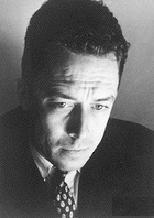 Albert
Camus (1913-1960) Albert
Camus (1913-1960)
Eugene
Ionesco (1912- )
|
|
|
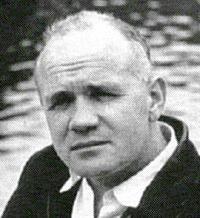 Jacques
Derrida (1930- ) Jacques
Derrida (1930- )
linguistics. Deridda
critiqued the idea that there is only a single "objective" way of interpreting
the meaning or intention of written text. In fact there are
multiple layers of meaning included in a text – as well as the fact that
the meaning of language shifts over the generations – which makes an absolute
reading of a text impossible. Study of language should thus proceed
from a psychoanalytic point of view that deconstructs the language of a
text into its motivational elements: what are the factors that caused
this language to take the form it did? Therein lies the true meaning
of the text.
philosophy. Truth is
not something that exists absolutely, in and of itself. Instead,
truth (such as we humans are able to receive) is the construct of the cultural
mind – a convenient shorthand or collection of metaphors used to express
cultural ideals.
ethics. We should not
be deceived by the outward logic of language but should look to the underlying
motivations of the person who uses language artfully to express deeply
lodged personal and cultural urges. We should be particularly sensitive
to personal and cultural biases and prejudices that are hidden beneath
the apparent logic.
We should also be very suspicious
of ideas that are put forth as absolute truths – realizing that they are
merely the covering over culturally subjective preferences etched out of
tradition and power structuring.
There is little point in arguing
the points of logic put forward in a debate – since such arguments are always
are merely self-serving personal and cultural political expressions .
Rather, the ideas that arise out of a particular cultural power mileu must
be countered with a new power milieu of its own. Truth is thus found
in action – not in logic.
 Derrida's
major works or writings: Derrida's
major works or writings:
L'origine de la géometrie
de Husserl (The Origin of the Geometry of Husserl)
(1962)
L'écriture et la différence
(Writing
and Difference)
(1967)
De la grammatologie (Of
Grammatology)
(1967)
La voix et le phénomène
(Speech
and Phenomena)
(1967)
La Dissemination
(Dissemination)
(1972)
Marges de la philosophie
(Margins
of Philosophy)
(1972)
Positions (1972)
L'archéologie du frivole
(Archeology of the Frivolous)
(1973)
Mallarme (1974)
Glas (1974)
Eperons: Les styles de Nietzsche
(Spurs:
Nietzsche's Styles)
(1978)
La vérité en
peinture (Truth in Painting)
(1979)
The Post Card (1980)
L'oreille de l'autre: Otobiographies,
transferts, traductions (The Ear of the Other)
(1982)
D'un ton apocalyptique adopté
naugère en philosophie (Raising the Tone of Philosophy)
(1983)
 Richard
Rorty (1931- ) Richard
Rorty (1931- )
An ardent defender of the radical
"Left" in American politics in the 1980s and 1990s.
 Rorty's
major works or writings: Rorty's
major works or writings:
Philosophy and the
Mirror of Nature (1979)
Contingency, Irony, and Solidarity
(1989)
"Feminism, Ideology, and Deconstruction:
a Pragmatist View" (Hypatia,
Spring, 1993)
"Moral Universalism and Economic
Triage" (UNESCO Philosophy Forum,
1996)
"First Projects, Then Principles"
(The Nation, Dec. 1997)
"Deconstructionist Theory"
(Stanford Presidential Lectures and Symposia in
the Humanities and Arts,
1995)
Achieving Our Country: Leftist
Thought in Twentieth-Century America
(1998)
|
|
|
Thomas J. J. Altizer
 Altizer's
major works or writings: Altizer's
major works or writings:
Radical Theology and
the Death of God (1966)
Paul van Buren
|
|
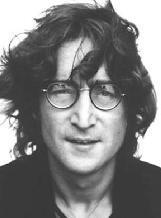 John
Lennon (1940-1980) John
Lennon (1940-1980)
Abbie
Hoffman (1936-1989)
 Hoffman's
major works or writings: Hoffman's
major works or writings:
Revolution
for the Hell of It (1968)
Woodstock
Nation (1969)
Steal
This Book (1971)
To America
with Love: Letters from the Underground (with Anita Hoffman,
1976)
Square
Dancing in the Ice Age (1982)
Steal
this Urine Test (with Jonathan Silvers, 1987)
"Reflections
on Student Activism" (speech on February 6, 1988)
 Allen
Ginsberg Allen
Ginsberg
 Ginsberg's
major works or writings: Ginsberg's
major works or writings:
Howl and Other Poems
(1956)
|
|
|
Elijah Mohammed
Malcolm X
Stokeley
Charmichael
Louis Farrakhan
|
|
Gloria
Steinem
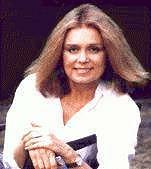 1934- . She grew up in conditions
of poverty in Toledo, Ohio, and did not have a stable schooling environment
until 12 years of age. But she overcame these hurdles and graduated
as a Phi Beta Kappa from Smith College in 1956. After graduation
she studied in India for two years, where she developed deeper familiarity
with Gandhian activism. 1934- . She grew up in conditions
of poverty in Toledo, Ohio, and did not have a stable schooling environment
until 12 years of age. But she overcame these hurdles and graduated
as a Phi Beta Kappa from Smith College in 1956. After graduation
she studied in India for two years, where she developed deeper familiarity
with Gandhian activism.
A co-founder (1968) and writer for
New
York Magazine until 1972, when she co-founded and then edited
the MS magazine until 1987. In 1971 she and other feminists
organized the National Women's Political Caucus. She is presently
President of the pro-choice political action committee called Voters of
Choice. In 1992, with her publication of Revolution from Within:
A Book of Self-Esteem, she took a more personal, even spiritual, approach
to women's issues.
 Steinem's
major works or writings: Steinem's
major works or writings:
Moving Beyond Words
(1994)
Revolution from Within: A
Book of Self-Esteem (1992)
Outrageous Acts and Everyday
Rebellions
Marilyn: Norma Jeane
(1986)
Carolyn Merchant
Evelyn Fox Keller
The "empathetic" scientist; need
to depose the patriarchal conception of nature
Paula Treichler
use of language to serve male interests
Francine Wattman
Frank
Susan Wolfe
linguistics
Marija Gimbutas
archeology
Ashley Montagu
Riane Eisler
archeology
Carol Gilligan
moral and developmental psychology
Jean Baker Miller
psychoanalysis
Nancy Chodorow
psychoanalysis
Stephanie de Voogd
epistemology
Barbara Eckman
epistemology |
|
EPISTEMOLOGY / THEORY OF KNOWLEDGE |
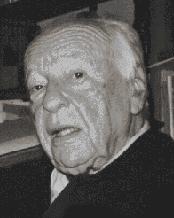 Hans-Georg
Gadamer (1900- ) Hans-Georg
Gadamer (1900- )
 Gadamer's
major works or writings: Gadamer's
major works or writings:
Wahrheit und Methode
(Truth and Method)
(1960)
Kleine Schriften (Philosophical
Hermeneutics)
(1967)
Dialogue and Dialectic
(1980)
Reason in the Age of Science
(1982)
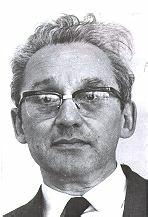 Paul
Ricoeur (1913- ) Paul
Ricoeur (1913- )
 Ricoeur's
major works or writings: Ricoeur's
major works or writings:
Philosophie de la
volonté (Philosophy of the Will) 3
vol. (1950-60)
Histoire et vérité
(History and Truth)
(1955)
Le Conflit des interprétations:
essais d'herméneutique (The Conflict of Interpretations:
Essays in Hermeneutics)
(1969)
Temps et récit
(Time and Narrative) 3
vol. (1983-1985)
|
|
PHILOSOPHY / THEOLOGY OF SCIENCE |
This is a marvelously expanding realm – for
science is not just "science" – but it is commentary on how we look at life
itself, how we understand the cosmos. The rapidly expanding number
of works by philosophers who are commenting on science and scientists who
reflect on the philosophy of their work attests to this "awakening."
And in the last ten years there has also been an equally rapidly expanding
realm of works on the theology of science – by both scientists and theologians.
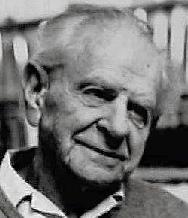 Karl
R. Popper (1902-1994) Karl
R. Popper (1902-1994)
Perhaps the greatest philosopher
of science of the 20th century. The main characteristic of his thinking
was his tendency to deconstruct the kind of abstract theorizing that leads
easily to religious and philosophical dogma – but at the same time to oppose
cynicism which often comes when theories seem to break down and despair
overtakes our thinking.
He was born to a professional-scholarly
Jewish family in Vienna in 1902 and raised with a great appreciation of
music. He entered the University of Vienna early, for a time flirted
with Marxism (but found it distastefully dogmatic), in 1928 received a
Ph.D. in philosophy, and in 1929 became accredited to teach mathematics
and physics.
This was the era of the dominance
of the Vienna Circle of Logical Positivists. Popper found himself
in disagreement with a number of their basic hypotheses, and in 1934 published
his first work, Logik der Forschung, in rebuttal to Logical Positivism.
On the basis of the attention that this work stirred, he was invited to
England to teach in 1935. He returned to Austria – then left the country
for New Zealand in 1937 as the Nazi movement developed in Austria.
Here he remained until War's end, eventually coming to England to teach
at the London School of Economics (1946). Here he produced countless
publications, including his classic, The Logic of Scientific Discovery
(1959), and achieved such stature that he was knighted in 1965. Though
he retired from the London School of Economics in 1969, he continued to
work tirelessly as witer and lecturer until his death in 1994.
 Popper's
major works or writings: Popper's
major works or writings:
The Logic of Scientific
Discovery (1959)
Conjectures and Refutations
(1968)
The Self and Its Brain
(with John C. Eccles) (1977)
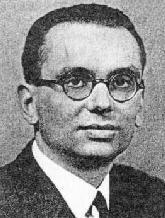 Kurt
Gödel (1906-1978) Kurt
Gödel (1906-1978)
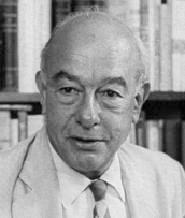 W.
V. O. Quine (1908- ) W.
V. O. Quine (1908- )
 Quine's
major works or writings: Quine's
major works or writings:
From a Logical Point
of View (2nd ed: 1961)
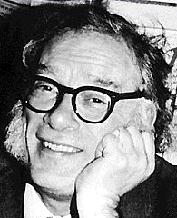 Isaac
Asimov (1920-1992) Isaac
Asimov (1920-1992)
Asimov was a prolific author, writing
over 500 books ranging in subject from general science, chemistry, astronomy,
physics, mathematics – to Western history, Biblical studies, mysteries,
surveys of literature. But of course he is best known for his many
science fiction novels and short stories.
He was born in Petrovichi, near Smolensk,
Russia, in early 1920, but moved with his family in 1923 to the United
States. He became an American citizen in 1928. He went on to
study chemistry at Columbia University in the 1930s and 1940s and then
to teach biochemistry at Boston University (School of Medicine) in the
1950s. In 1958 he began to devote himself full-time to his writings – which
by then had become very popular. In 1977 he founded the Isaac
Asimov's Science Fiction Magazine. He died in 1992 in New York
City.
 Asimov's
major works or writings (too numerous to list separately): Asimov's
major works or writings (too numerous to list separately):
A Catalogue of Isaac
Asimov's Books (Ed Seiler)
Thomas Kuhn (1922-
)
 Kuhn's
major works or writings: Kuhn's
major works or writings:
The Structure of Scientific
Revolutions (1962)
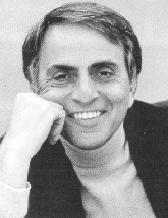 Carl
Sagan (1934-1996) Carl
Sagan (1934-1996)
astronomer (NASA) and professor;
science popularizer. Professor of Astronomy and Space Sciences at
Cornell University; also Director of the Laboratory for Planetary Studies
(Cornell University). Focused research on the question of the origins
of life. Co-founder and President of The Planetary Society
 Sagan's
major works or writings: Sagan's
major works or writings:
Broca's Brain(1974)
Cosmos
(1980)
Michael Polanyi
 Polanyi's
major works or writings: Polanyi's
major works or writings:
Personal Knowledge
(1958)
The Tacit Dimension
Knowing and Being(1969)
Roger Penrose
(1931- )
A very versatile scientist, Penrose
was trained in mathematics/geometry, worked with Hawking in developing
the concept fo the singularity that reigns at the center of black holes,
and schematicised the forces of space-time surrounding black holes.
He has also ventured into study of the physical working of the human mind,
in an attempt to understand human consciousness.
 Penrose's
major works or writings: Penrose's
major works or writings:
The Emperor's New
Mind: Concerning Computers, Minds and the Laws of Physics (1989)
Shadows of the Mind: A Search
for the Missing of Science of Consciousness
(1994)
Edward R. Harrison
 Harrison's
major works or writings: Harrison's
major works or writings:
Cosmology
(1981)
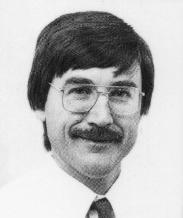 Paul
Davies Paul
Davies
 Davie's
major works or writings: Davie's
major works or writings:
God and the New Physics
(1983)
The Forces of Nature
(1986)
The Cosmic Blueprint
(1987)
The Mind of God(1991)
About Time (1995)
The Last Three Minutes: Conjectures
about the Ultimate End of the Universe
John D. Barrow
Astronomer
 Barrow's
major works or writings: Barrow's
major works or writings:
The Anthropic Cosmological
Principle (1986) (with Frank Tipler)
The World Within the World
(1988)
Theories of Everything
(1991)
The Origin of the Universe
Robert H. March
 March's
major works or writings: March's
major works or writings:
Physics for Poets
(1978)
Fritz Rohrlich
 Rohrlich's
major works or writings: Rohrlich's
major works or writings:
From Paradox to Reality
(1987)
F. David Peat
 Peat's
major works or writings: Peat's
major works or writings:
Synchonicity
(1987)
Superstrings and the Search
for the Theory of Everything (1988)
Turbulent Mirror (1989)
(with John Briggs)
The Philosopher's Stone
(1991)
Ian Barbour
 Barbour's
major works or writings: Barbour's
major works or writings:
Myths, Models, and
Paradigms (1974)
Religion in an Age of Science
(1990)
Ethics in an Age of Technology
(1991)
John Polkinghorne
Physicist/Anglican priest/President
of Queens College, Cambridge
 Polkinghorne's
major works or writings: Polkinghorne's
major works or writings:
The Particle Play(1979)
The Way the World Is (1983)
One World: The Interaction
of Science and Theology (1987)
Science and Creation
(1988)
Science and Christian Belief
(1994)
Quarks, Chaos & Christianity
(1996)
Arthur Peacocke
Biochemist
 Peacocke's
major works or writings: Peacocke's
major works or writings:
Creation and the World
of Science (1979)
(ed.) The Sciences and Theology
in the Twentieth Century(1981)
Intimations of Reality(1984)
God and the New Biology
(1986)
Wim B. Drees
 Drees'
major works or writings: Drees'
major works or writings:
Beyond the Big Bang:
Quantum Cosmologies and God (1990)
Thomas Torrance
(1913- )
Neo-orthodox unifier of theology
and science
 Torrance's
major works or writings: Torrance's
major works or writings:
Theological Science(1969)
Divine and Contingent Order(1981)
Transformation and Convergence
in the Frame of Knowledge (1984)
The Christian Frame of Mind
(1989)
Langdon Gilkey
 Gilkey's
major works or writings: Gilkey's
major works or writings:
Maker of Heaven and
Earth (1959)
Religion and the Scientific
Future (1970)
Creationism on Trial(1985)
Ernan McMullin
warns of the dangers of theology
following science: God of the "gaps"
 McMullin's
major works or writings: McMullin's
major works or writings:
(ed.) Evolution and
Creation (1985)
I. Stewart
 Stewart's
major works or writings: Stewart's
major works or writings:
Does God Play Dice?
The Mathematics of Chaos (1989)
WESTERN CULTURE AND ITS CRITICS |
|
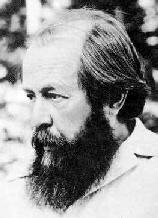 Aleksandr
Solzhenitsyn (1918- ) Aleksandr
Solzhenitsyn (1918- )
 Solzhenitsyn's
major works or writings: Solzhenitsyn's
major works or writings:
One Day in the Life
of Ivan Denisovich(1962)
Cancer Ward(1969)
Gulag Archipelago
(1973)
A World Split Apart
(1978)
Paul Johnson
 Johnson's
major works or writings: Johnson's
major works or writings:
Modern Times
Allan Bloom
 Bloom's
major works or writings: Bloom's
major works or writings:
The Closing of the
American Mind (1987)
Alasdair MacIntyre
 MacIntyre's
major works or writings: MacIntyre's
major works or writings:
After Virtue
(1981)
Russell Kirk
 Kirk's
major works or writings: Kirk's
major works or writings:
Beyond the Dreams
of Avarice (1956)
Confessions of a Bohemian
Tory (1963)
The Roots of American Order
(1974)
Enemies of the Permanent Things
Robert N. Bellah
 Bellah's
major works or writings: Bellah's
major works or writings:
Religious Evolution
(1964)
Beyond Belief (1970)
Habits of the Heart
(1985) (with others)
E. F. Schumacher
 Schumacher's
major works or writings: Schumacher's
major works or writings:
Small Is Beautiful(1973)
|
|
SCIENCE
AND EASTERN PHILOSOPHY |
|
Fritjof
Capra (1939- )
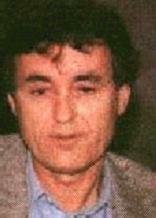 Seeking to create a unified theory
of existence using modern science and ancient mysticism. Modern relativity
and quantum theory in fact can be understood only through mystical monism.
For instance – the understanding that mass and energy are one and the same
points to the basic monism of the universe. Seeking to create a unified theory
of existence using modern science and ancient mysticism. Modern relativity
and quantum theory in fact can be understood only through mystical monism.
For instance – the understanding that mass and energy are one and the same
points to the basic monism of the universe.
Or – the understanding of relativity
and quantum theory that there can be no objectivity in scientific analysis
points to the lack of existence of any Absolute objective reality: all
is brought into being through the grip of consciousness – human and divine
(which themselves are one).
 Capra's
major works or writings: Capra's
major works or writings:
The Tao of Physics(1975)
The Turning Point: Science,
Society and the Rising Culture (1982)
Uncommon Wisdom (1988)
The Web of Life: A New Scientific
Understanding of Living Systems (1996)
Gary Zukav
We have arrived at the end of scientific
reductionism with the relativity and quantum theories. What we now
need is a unifying theory of existence – one which reconnects us with our
reality. For this we have to turn to Eastern mysticism.
 Zukav's
major works or writings: Zukav's
major works or writings:
The Dancing Wu-Li
Masters
Lawrence LeShan
 LeShan's
major works or writings: LeShan's
major works or writings:
The Medium, the Mystic
and the Physicist (1976)
From Newton to ESP
(1984)
|
|
THE HUMAN POTENTIAL MOVEMENT |
|
Werner Erhard
(founder of est)
M. C. Richards
 Richard's
major works or writings: Richard's
major works or writings:
Centering
(1964)
Jose Silva
 Silva's
major works or writings: Silva's
major works or writings:
The Silva Mind Control
Method (1977)
|
|
THE NEW AGE MOVEMENT: MAJOR
FIGURES |
|
Basically, the New Age Movement
is a modern form of gnosticism – though unlike traditional gnosticism which
despised the world, New Age gnosticism is very world affirming It
is also the child of Theosophy, popular during the last days of the 19th
century and the early part of this century.
The Movement grew up out of the cultural
revolution of the 1960s. It reflects deeply the agonies of a time
when so many youthful Westerners ("Boomers") discovered the down-side of
the materialistic, secular culture they had been raised to adore.
It moves forward in deep reaction
to the existential dead-end created by modern science and the secular or
materialist spirit of modern culture. The Movement also moves in reaction
to traditional religion – which it considers bound to an unenlightened past
and thus is useless today. And it moves in reaction to the passiveness
that characterizes a culture of increasing State intervention: the
Movement stresses the importance of self-responsibility. Among the
things New Agers feel responsible for is not only their personal welfare,
but the welfare of the world itself in an age of pollution and nuclear
threats. They seek a transformation of the planet we live on as well
as our personal transformation. The two are inextricably intertwined.
The name "New Age" comes from the
notion that the world is about to emerge out of the Age of Pisces (the
Christian era) into a New Age of Aquarias (with intellectual borrowings
from Hinduism). It will do so as human consciousness (sometimes called
"Christ-consciosness" – which, however, is not uniquely Jesus's) is raised
through various consciousness-raising techniques to the realization that
we all are Divinity ourselves. We have been evolving inevitably toward
this New or Aquarian Age of human enlightenment, love and peace.
But it is imperative that we actively strive to achieve Higher or Divine
Consciousness in order to usher in this New Age of Aquarius.
In the New Age we will find ourselves
in a spirit of one-ness (monism) with the universe (as well as the divine
force which created it and is to be found inherent within it). The
reality of the underlying spiritual unity of all things in God or the Divine
One will soon become evident to all of us.
New Agers do not believe in sin or
the need for atonement. Rather they believe in ignorance which causes
us to err. Enlightenment, not Christ-atonement, is the solution to this
problem. Also, many of them believe in karma, the idea that one's
bad deeds are "paid for" by the imposition of difficulties in one's life
(and future lives) – as also one's good deeds are rewarded by receiving
good consequences in this and future lives. No Christ-atonement can compensate
for the iron law of karma.
In keeping with the rise of militant
feminism, with its efforts to dethrone "patriarchy" which it sees as permeating
our culture, there is also a strong feminist component in the Movement.
Earth Mother is often put forward as a much more evolved divine consciousness
for us to focus our thoughts and meditations on. Earth Mother is
supposedly a more joyous, peaceloving and life-affirming divinity – than
the male sky gods such as Yahweh and the Abba of Jesus. These male
sky gods are warlike, domineering, legalistic and life-denying – unworthy
divinities for an Age of Aquarius. Such male gods need to be dethroned.
The New Age "dogmatics" are in a
state of great flux and by no means regularized or uniform. The Movement
is highly ecclectic and New Agers may delve into different aspects of the
movement as they grow toward the ideal of self-enlightenment. Thus
they may be "into" TM (Transcendal Meditation) for a while, or Zen, or
est, or the Green Movement, or the peace movement, or holistic foods and
healing, etc.
Also, they tend toward the mystical
in their interpretation of life. Astrology is very popular among
New Agers – and many are into channeling (the consulting of spiritual mediums)
and practicing occult spiritual technologies.
Some, more marginal to the movement,
are into cults (led by such gurus as Bhagwan Shree Rajneesh) or broad-based
movements such as the Sufi Order of the West or the Movement of Spiritual
Inner Awareness. But most New Agers are quite independent spirits
and tend away from cultic behavior. Such rigid movements as Hare
Krishna or the Moonies thus fall outside the New Age Movement – even though
they share many ideas and practices in common.
Alan Watts
 Watts'
major works or writings: Watts'
major works or writings:
The Supreme Identity
(1950)
The Two Hands of God
(1963)
The Book (1966)
Maharishi Mahesh
Yogi
popularizer of transcendal meditation
(TM)
 The
Maharishi's major works or writings: The
Maharishi's major works or writings:
The Science of Being
and Art of Living (1963)
Inauguration of the Dawn of
the Age of Enlightenment (1975)
Carlos Castaneda
 Castaneda's
major works or writings: Castaneda's
major works or writings:
The Teachings of Don
Juan (1970)
A Separate Reality
(1971)
Marilyn Ferguson
 Ferguson's
major works or writings: Ferguson's
major works or writings:
The Brain Revolution
(1973)
The Aquarian Conspiracy
(1980) celebrating the supposed existence of a large network of Aquarians
who intend to organize a new global culture, a step forward in human evolution
David Spangler
former leader of Findhorn (Scottish
New Age training center)
 Spangler's
major works or writings: Spangler's
major works or writings:
Revelation
(1976)
Towards a Planetary Vision
(1977)
Reflections on the Christ
(1981)
Donald Keys
co-founder and president of Planetary
Citizens; political activist, influential with United Nations delegations
 Key's
major works or writings: Key's
major works or writings:
Earth at Omega
(1982)
Mark Satin
 Satin's
major works or writings: Satin's
major works or writings:
New Age Politics
(1978)
Radical Middle Newletter
Benjamin Creme
Theosophist; head of the Tara Center
 Creme's
major works or writings: Creme's
major works or writings:
The Reappearance of
the Christ and the Masters of Wisdom (1980)
Jean Houston
psychologist
The Hollywood
Connection:
Shirley MacLaine
Out on
a Limb
Dancing
in the Light
John Denver
Oprah Winfrey
Others:
Alvin Toffler futurist
Margaret Mead. anthropologist
Barry McWaters psychologist.
Conscious
Evolution (1981)
Edgar Mitchell scientist
and astronaut; creator of Institute of Noetic Sciences. The world
of physical matter and conscious spirit are one (pantheism). Consciousness
is the basis of all existence – physical and psychic. Modern science
and ancient mysticism need to be synthesized into a new science. Mind
at Large
William Irwin Thompson
social historian. Passages about Earth (1973)
Theodore Roszak cultural
historian
Richard Tarnas cultural
historian. Former Director of Programs and Education at the Esalen
Institute; now Professor of Philosophy and Psychology at the California
Institute of Integral Studies. The Passion of the Western Mind (1991)
Jacob Needleman philosopher.
The
Heart of Philosophy (1984)
Lola Davis Toward a
World Religion for the New Age (1983)
Moira Timms Prophecies
and Predictions
LaVedi Lafferty and
Bud
Hollowell The Eternal Dance
Corrine Heline New Age
Bible Interpretation
Robert Muller New Genesis
Vera Alder When
Humanity Comes of Age
Beverly Galyean Confluent Education
George Trevelyan British
Vision of the Aquarian Age and
Operation Redemption (1984)
John Walsh Intercultural
Education in the Community of Man
Norman Cousins editor
of Saturday Review |
|
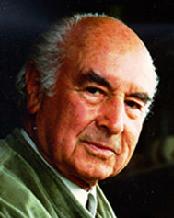 Albert
Hofmann (1906- ) Albert
Hofmann (1906- )
 Hofmann's
major works or writings: Hofmann's
major works or writings:
LSD: My Problem Child:
Reflections on Sacred Drugs, Mysticism, and Science (1979)
The Botany and Chemistry of
Hallucinogens (with
Richard Evans Schultes,1980)
Plants of the Gods(with
Richard Evans Schultes,1992)
Insight Outlook(1989)
Entheogens and the Future
of Religion (with others, 1997)
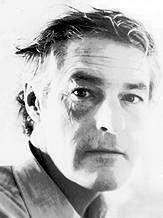 Timothy
Leary (1920-1996) Timothy
Leary (1920-1996)
 Leary's
major works or writings: Leary's
major works or writings:
Psychedelic Experience
(1964)
The Politics of Ecstasy
(1965)
High Priest (1968)
What Does Woman Want (1978)
Changing My Mind Among Others
(1982)
Chaos and Cyber Culture
(1994)
Design for Dying (1997)
Flashbacks (1997)
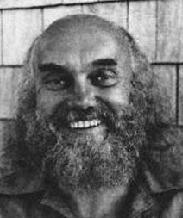 Ram
Dass (Richard Alpert) (1933- ) Ram
Dass (Richard Alpert) (1933- )
Psychologist and New Age lecturer.
Experimented with Timoth Leary in chemically induced altered states of
consciousness in the 1960s.
 Ram
Dass' major works or writings: Ram
Dass' major works or writings:
Psychedelic Experience
(1964)
LSD (1966)
The Only Dance There Is
(1970)
Be Here Now (1971)
How Can I Help? (1985)
Grist for the Mill
(1988)
Journey of Awakening
(1990)
Between Heaven and Earth
(1991)
Compassion in Action
(1992)
Soma: The Divine Hallucinogen
(1999)
|
|
CHANNELING [BEING A "MEDIUM"]
AND THE OCCULT |
Jane Roberts
 Roberts'
major works or writings: Roberts'
major works or writings:
The Seth Material
(1970)
Seth Speaks (1972)
J. Z. Knight ("Ramtha")
 Knight's
major works or writings: Knight's
major works or writings:
Voyage to the New
World (1985)
Kevin Ryerson
A medium who brought Shirley MacLaine
into the New Age fold
Jon Klimo
 Klimo's
major works or writings: Klimo's
major works or writings:
Channeling
(1987)
Other Channels:
Jach Pursel ("Lazarus")
Darryl Anka ("Bashar")
Alan Vaughan ("Li Sung")
Penny Torres Rubin ("Mafu")
Azena Ramanda ("Saint Germaine")
Kathryn Paulsen
 Paulsen's
major works or writings: Paulsen's
major works or writings:
The Complete Book
of Magic and Witchcraft
Miriam Starhawk
 Starhawk's
major works or writings: Starhawk's
major works or writings:
The Spiral Dance(1979)
Dreaming the Dark
(1982)
|
|
THE SECOND
HALF OF THE 20TH CENTURY:
A FULL STORY |

 Miles
H. Hodges Miles
H. Hodges
|


 Karl
R. Popper (1902-1994)
Karl
R. Popper (1902-1994)![]() Popper's
major works or writings:
Popper's
major works or writings:
 Kurt
Gödel (1906-1978)
Kurt
Gödel (1906-1978)
 W.
V. O. Quine (1908- )
W.
V. O. Quine (1908- )
![]() Quine's
major works or writings:
Quine's
major works or writings:
 Isaac
Asimov (1920-1992)
Isaac
Asimov (1920-1992)![]() Asimov's
major works or writings (too numerous to list separately):
Asimov's
major works or writings (too numerous to list separately):
![]() Kuhn's
major works or writings:
Kuhn's
major works or writings:
 Carl
Sagan (1934-1996)
Carl
Sagan (1934-1996)
![]() Sagan's
major works or writings:
Sagan's
major works or writings:
![]() Polanyi's
major works or writings:
Polanyi's
major works or writings:
![]() Penrose's
major works or writings:
Penrose's
major works or writings:
![]() Harrison's
major works or writings:
Harrison's
major works or writings:
 Paul
Davies
Paul
Davies
![]() Davie's
major works or writings:
Davie's
major works or writings:
![]() Barrow's
major works or writings:
Barrow's
major works or writings:
![]() March's
major works or writings:
March's
major works or writings:
![]() Rohrlich's
major works or writings:
Rohrlich's
major works or writings:
![]() Peat's
major works or writings:
Peat's
major works or writings:
![]() Barbour's
major works or writings:
Barbour's
major works or writings:
![]() Polkinghorne's
major works or writings:
Polkinghorne's
major works or writings:
![]() Peacocke's
major works or writings:
Peacocke's
major works or writings:
![]() Drees'
major works or writings:
Drees'
major works or writings:
![]() Torrance's
major works or writings:
Torrance's
major works or writings:
![]() Gilkey's
major works or writings:
Gilkey's
major works or writings:
![]() McMullin's
major works or writings:
McMullin's
major works or writings:
![]() Stewart's
major works or writings:
Stewart's
major works or writings:



 Albert
Camus (1913-1960)
Albert
Camus (1913-1960) Jacques
Derrida (1930- )
Jacques
Derrida (1930- )
 Richard
Rorty (1931- )
Richard
Rorty (1931- )
 John
Lennon (1940-1980)
John
Lennon (1940-1980) Allen
Ginsberg
Allen
Ginsberg 1934- . She grew up in conditions
of poverty in Toledo, Ohio, and did not have a stable schooling environment
until 12 years of age. But she overcame these hurdles and graduated
as a Phi Beta Kappa from Smith College in 1956. After graduation
she studied in India for two years, where she developed deeper familiarity
with Gandhian activism.
1934- . She grew up in conditions
of poverty in Toledo, Ohio, and did not have a stable schooling environment
until 12 years of age. But she overcame these hurdles and graduated
as a Phi Beta Kappa from Smith College in 1956. After graduation
she studied in India for two years, where she developed deeper familiarity
with Gandhian activism. Hans-Georg
Gadamer (1900- )
Hans-Georg
Gadamer (1900- ) Paul
Ricoeur (1913- )
Paul
Ricoeur (1913- ) Aleksandr
Solzhenitsyn (1918- )
Aleksandr
Solzhenitsyn (1918- )
 Seeking to create a unified theory
of existence using modern science and ancient mysticism. Modern relativity
and quantum theory in fact can be understood only through mystical monism.
For instance – the understanding that mass and energy are one and the same
points to the basic monism of the universe.
Seeking to create a unified theory
of existence using modern science and ancient mysticism. Modern relativity
and quantum theory in fact can be understood only through mystical monism.
For instance – the understanding that mass and energy are one and the same
points to the basic monism of the universe.
 Albert
Hofmann (1906- )
Albert
Hofmann (1906- ) Timothy
Leary (1920-1996)
Timothy
Leary (1920-1996) Ram
Dass (Richard Alpert) (1933- )
Ram
Dass (Richard Alpert) (1933- )

